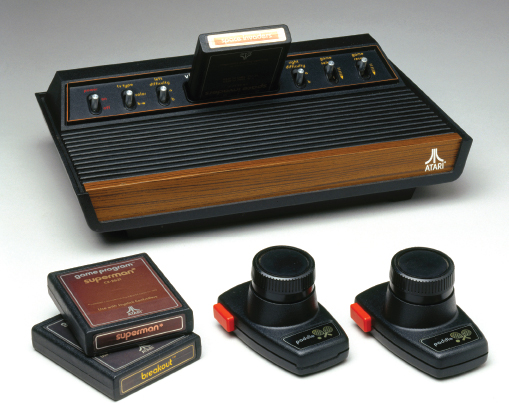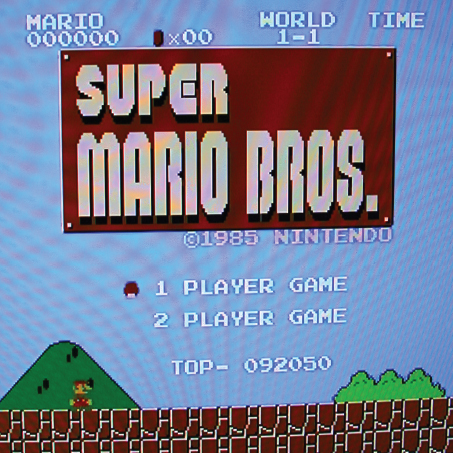Consoles and Advancing Graphics
“In Mario, the squat Italian plumber who bops around the Mushroom Kingdom in a quest to rescue Princess Toadstool, [Shigeru] Miyamoto created a folk hero—gaming’s first—with as great a reach as Mickey Mouse’s.”
NICK PAUMGARTEN, NEW YORKER, DECEMBER 2010
Today, many electronic games are played on home consoles, devices specifically used to play video games. These systems have become increasingly more powerful since the appearance of the early Atari consoles in the 1970s. One way of charting the evolution of consoles is to track the number of bits (binary digits) that they can process at one time. The bit rating of a console is a measure of its power at rendering computer graphics. The higher the bit rating, the more detailed and sophisticated the graphics. The Atari 2600, released in 1977, used an 8-bit processor, as did the wildly popular Nintendo Entertainment System, first released in Japan in 1983. Sega Genesis, the first 16-bit console, appeared in 1989. In 1992, 32-bit computers appeared on the market; the following year, 64 bits became the new standard. The 128-bit era dawned with the marketing of Sega Dreamcast in 1999. With the current generation of consoles, 256-bit processors are the standard.
But more detailed graphics have not always replaced simpler games. Nintendo, for example, offers many of its older, classic games for download onto its newest consoles even as updated versions are released, for the nostalgic gamers as well as new fans. Perhaps the best example of enduring games is the Super Mario Bros. series. Created by Nintendo mainstay Shigeru Miyamoto in 1983, the original Mario Bros. game began in arcades. The 1985 sequel Super Mario Bros., developed for the 8-bit Nintendo Entertainment System, became the best-selling video game of all time. It held this title until as recently as 2009, when it was unseated by Nintendo’s Wii Sports. Graphical elements from the Mario Bros. games, like the “1UP” mushroom that gives players an extra life, remain instantly recognizable to gamers of many ages. Some even appear on nostalgic T-shirts, as toys and cartoons, and in updated versions of newer games.

Through decades of ups and downs in the electronic gaming industry (Atari folded in 1984, and Sega no longer makes video consoles), three major home console makers emerged: Nintendo, Microsoft, and Sony. Nintendo has been making consoles since the 1980s; Microsoft and Sony came later, but both companies were already major media conglomerates and thus well positioned to support and promote their interests in the video game market. Veteran electronics manufacturer Sony has the third most popular console, with its PlayStation series, introduced in 1994. Its current console, the PlayStation 4 (PS4), boasts more than ninety million users on its online PlayStation Network. Sony introduced PlayStation Move, its handheld remote motion-sensing controller, in 2010. Microsoft’s first foray into video game consoles was the Xbox, released in 2001 and linked to the Xbox LIVE online service in 2002. Xbox LIVE lets its forty-six million subscribers play online and enables users to download new content directly to its current console, the Xbox One. In 2011, this was the world’s second most popular console, and its sales grew faster than any competitor with the introduction of the Kinect motion-sensing controller in 2010.8 In 2013, Microsoft released the Xbox One, with an upgraded Kinect, as an advanced gaming device and voice-controlled entertainment system.

Nintendo released its most recent console, the Wii, in 2006. The device supports traditional video games like New Super Mario Bros. However, it was the first of the three major consoles to add a wireless motion-sensing controller, which took the often-sedentary nature out of gameplay. Games like Wii Sports require the user to mimic the full-body motion of bowling or playing tennis, while Wii Fit uses a wireless balance board for interactive yoga, strength, aerobic, and balance games. Although the Wii has lagged behind Xbox and PlayStation in establishing an online community, its controller enabled a host of games that appealed to broader audiences, and it became the best-selling of the three major console systems. In 2012, Nintendo introduced the Wii U, which features the GamePad, a controller with an embedded touchscreen, on which games can be played without a television set (making it like a handheld video player).
The three major consoles share some game content, but not every popular game works on all three platforms, a selling point which might cause users to prefer one system over another. For example, Call of Duty: Black Ops 2 (by Activision Blizzard), Epic Mickey 2 (by Disney Interactive Studios), and Just Dance 4 (by Ubisoft) come in versions for all three consoles (and personal computers running Microsoft Windows, too). But the console makers also create games just for their own platform: Dead Rising 3 for the Xbox One, DRIVECLUB for the PlayStation 4, and The Last Story for the Wii.